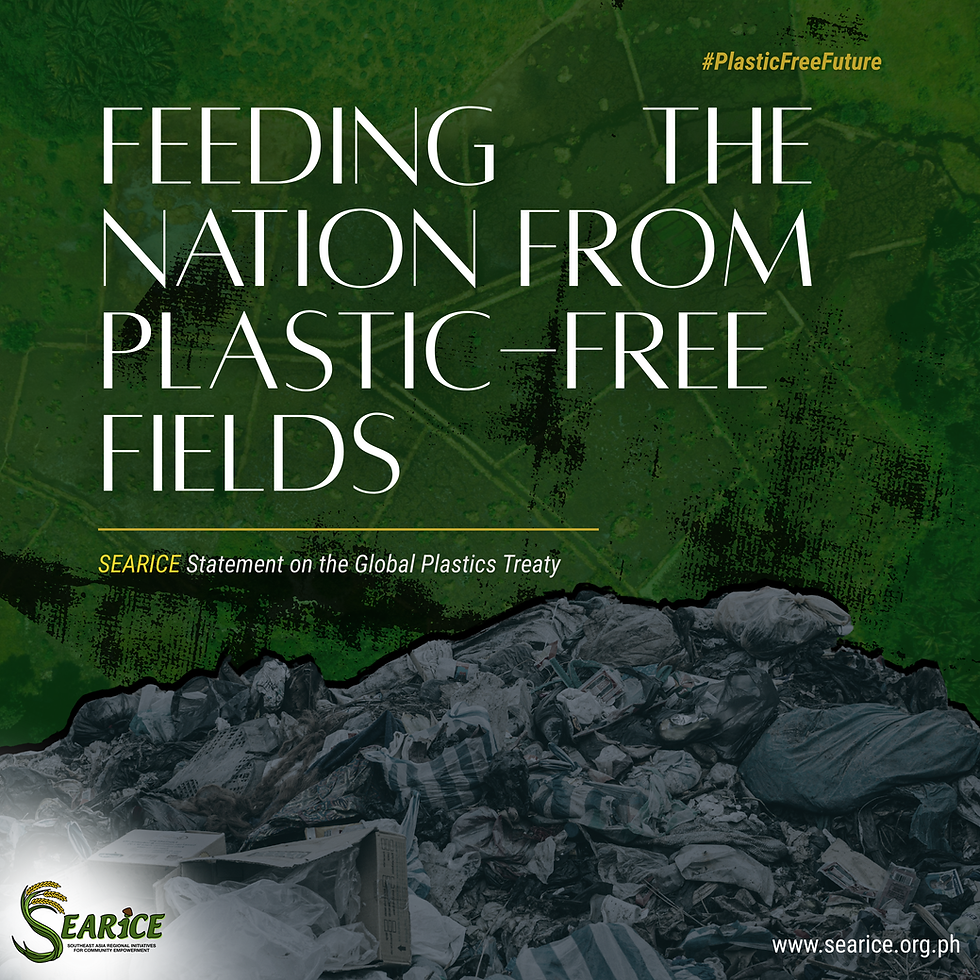SEARICE statement at the 18th meeting of the Convention on Biological Diversity (CBD) Subsidiary Body on Scientific, Technical and Technological Advice (SBSTTA)
- SEARICE Staff
- Jun 28, 2014
- 4 min read
Updated: Sep 26, 2024
SEARICE Position Statement on New and Emerging Issue: Synthetic Biology (Item 6)
SEARICE thanks the CBD Secretariat for Document UNEP/CBD/SBSTTA/18/10, which succinctly and categorically outlines the substantial and extensive uncertainties and risks of synthetic biology.
In the spirit of taking a precautionary approach in accordance with Paragraph 4, Decision XI/11, and taking into account the immense, “catastrophic”, and “existential” risks, synthetic biology clearly deserves the scrutiny of the Body in order for the objectives of the Convention to be met and not hampered.
First, it is relevant to the issue of implementation of the Objectives of the Convention and its existing programmes of work. The novel organisms and their components emerging from the application of techniques of synthetic biology pose actual and potential impediments to all three pillars of the Convention: the conservation of biological diversity, the sustainable use of its components, and the fair and equitable sharing of the benefits arising from the use of genetic resources. In particular, the issue adds new dimensions to the programmes of work on agricultural biodiversity, biofuels, climate change, invasive alien species, traditional knowledge, and access and benefit-sharing.
As to the second, third and fourth criteria, we take these to include evidence of potential harm, as it would be illogical to ask for solid confirmation of actual impacts at the stage where the technology is new and emerging and there is scientific uncertainty. This is exactly where the precautionary principle applies as recognized in Decision X1/11. According to the documents prepared by the Executive Secretary, even researchers reflect a concern for the unknown unknowns, and call for significantly increased efforts on dedicated synthetic biology risk research. This is a welcome recommendation, and one that SEARICE supports.
Fifth, the regulatory gaps identified in the information documents give evidence of the absence or limited availability of tools to limit or mitigate the negative impacts. For example, the Cartagena Protocol does not contain non-living modified organisms, i.e., it does not cover some synthetic biology techniques that go beyond genetic engineering or are intended for contained use. To emphasize, “The international regulatory framework is not well-equipped to address potentially catastrophic and existential risks with low and very low probability but immense impacts.”
Lastly, on the magnitude of actual and potential effects on human well-being and productive sectors and economic security, SEARICE would like to highlight the socio-economic impacts on communities engaged in the production of competing goods; especially where traditional livelihoods and practices have created the rich biodiversity that humanity enjoys, but is in danger of being lost.
One of these threatened traditional livelihoods is coconut farming. Today, the Philippines provides for 46.2 percent of coconut oil, and exports 59 percent of coconut in the world. Twenty five percent of the population depends on coconut farming, growing them on relatively small-sized farms with an average area of 2.4 hectares (ha).
Coconut farms in the Philippines, numbering to 1.4 million, are owner-operated. Only the best varieties available in the locality as identified by farmers, and other promising local varieties recommended by the Philippine Coconut Authority are used. Seed production is participatory, with farmers sourcing their own seedlings, which are sown and propagated in their own nurseries to generate good seedlings. They produce and use only open-pollinated varieties. The coconuts are organically grown. Coconut cultivation in the Philippines generally does not require chemical inputs, and other crops are often grown together under the shade of these tall trees. These practices ensure agricultural biodiversity in what is regarded by the people as the “Tree of Life.”
Significantly, coconut farming also contributes to the economies of Malaysia, Indonesia, India, Vietnam, Mexico, Nigeria, Thailand and Papua New Guinea.
Market or non-market incentives for coconut farmers to continue their practices would be for naught if the sweeping effects of synthetic biology products, aided by concentration of capital and intellectual property rights, are left unchecked. Land use changes in response to these market pressures will be inevitable. The Philippines is trying to hold on to its rich biodiversity, thanks in no small part to the sustainable practices and stewardship of its local communities, which also bear the weight of fighting against land grabbing cases.
SEARICE believes that the definition of synthetic biology which the Subsidiary Body will recommend, if any, must be comprehensive enough to cover related techniques that may be developed in the future, in particular where they pose the same type and level of risks. To do this, we recommend that SBSTTA propose an expansive definition accompanied in an annex by a living list of techniques, approaches, and hallmarks of Synthetic Biology that can be subsequently updated as this fast-moving field evolves.
SEARICE takes exception to some elements of the draft recommendation prepared by the Executive Secretary. Foremost, we are concerned about the absence of a language of precaution. This was clearly articulated in Decision X1/11 and must be reaffirmed. There is also no mention of regulatory standards for contained use, given that the escape of fast-evolving microorganisms used in current and near-term application is still possible. The provision does not mention what these benefits are and for whom they are intended. Lastly, there should be capacity-building support in risk assessment provided to developing countries. [Ends]


